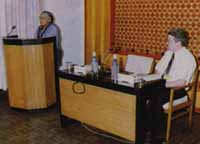Workshop on “Micrographic Techniques”
Micrographics is a vast expanding technology. The tremendous advances it has made since the beginning of the last decade has given a new generation of micrographic hardware as well as improved technology. Application areas have been enlarged and by interfacing with other emerging technologies it has become a powerful component of information storage and management system. Latest techniques have come up for creating microforms of permanent excellence, making them available to the users in quickest possible time and storing them archivally.
Keeping this in view a three-day workshop on “Micrographic Techniques” was organized at IGNCA, from April 25 to 27, 1994. It was aimed at giving the operational hands in the public and private sector concerns and scholars and other connected with the IGNCA’s projects at academic, executive and operational levels, an exposure to the latest technologies and also an opportunity to interact with the specialists and experts in this field.
The workshop was devised to demonstrate theoretical deliberations practically with extensive hands on exercise at the workstations and laboratories. Emphasis was laid more on the current upgraded production techniques of different generations of microforms, their processing, proper evaluation, quality parameters, storage and retrieval, proper cataloguing for manual as well as computer applications and finally basic understanding of this preservation and conservation needs.
The workshop was inaugurated by Dr. Kapila Vatsyayan, Academic Director, IGNCA. She appreciated its objective and expressed the hope that the workshop would realise the same through the deliberations and hand-down training of participants.
The workshop was spread over 11 technical sessions in which 8 papers dealing with all the aspects of micrographics from production stage to storage and retrieval were presented, discussed and followed by practical sessions with hands-on exercise. Judging from the response and lively interaction of the participants with the experts, the workshop has been an unqualified success and its objective fully realised. This was endorsed by the participants in the concluding session with their renewal appeal for holding such workshops periodically for the benefit of all those engaged in this field and which has been accepted in principle.
The workshop was attended by 23 delegates including some international experts. Experts from different institutes voiced their concepts, concern and shared the state-of-the-art technology. Sh. A.K. Avasthy of Nehru memorial Museum and Library, said: “Micrographics combines the science, art and technology by which information can be quickly reduced to the medium of microfilm, stored conveniently and then easily retrieved for reference and use”. Mr. Thatcher of Genealogical Society of Utah stressed that Microfilms has no substitute for preservation of archival records, though, today we have latest technology like Optical Disc, etc. The longevity of a Disc is not more than 20 to 25 years whereas the microfilms can last more than 100 years. B.K. Rampal concluded: ” In the coming years, integration of micrographic technology with computer technology is likely to play greater role and offer benefits to a broader audience and extend its application to new fields”.
– B.K. Rampal
[ Newsletter | List of Newsletter ]





